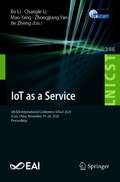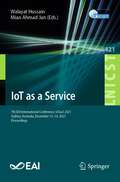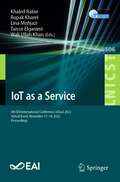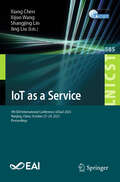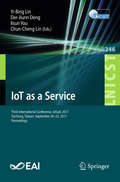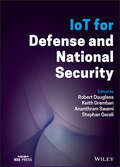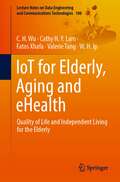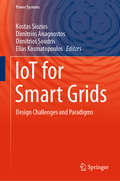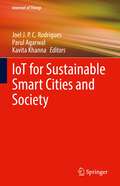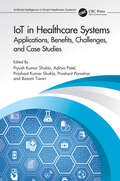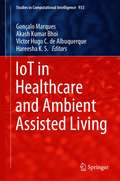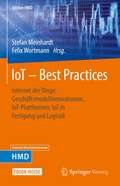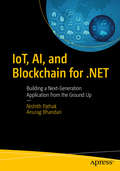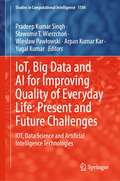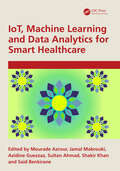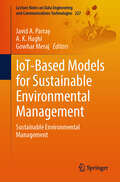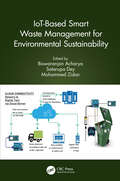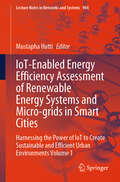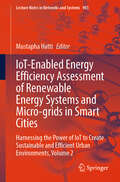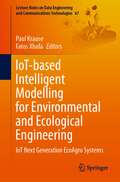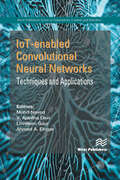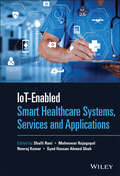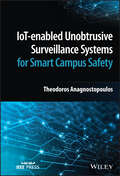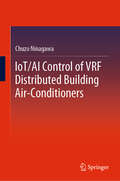- Table View
- List View
IoT as a Service: 6th EAI International Conference, IoTaaS 2020, Xi’an, China, November 19–20, 2020, Proceedings (Lecture Notes of the Institute for Computer Sciences, Social Informatics and Telecommunications Engineering #346)
by Bo Li Mao Yang Zhongjiang Yan Jie Zheng Changle LiThis book constitutes the refereed post-conference proceedings of the 6st International Conference on IoT as a Service, IoTaaS 2020, which took place in Xi’an, China, in November 2020. Due to COVID-19 pandemic the conference was held virtually. The 69 revised full papers were carefully reviewed and selected from 136 submissions. The papers present two technical tracks and three workshops: The Second Workshop on Edge Intelligence and Computing for Iot Communications and Applications, the Workshop on Satellite Communication Networks for Internet of Things, the Workshop on Satellite Communications
IoT as a Service: 7th EAI International Conference, IoTaaS 2021, Sydney, Australia, December 13–14, 2021, Proceedings (Lecture Notes of the Institute for Computer Sciences, Social Informatics and Telecommunications Engineering #421)
by Mian Ahmad Jan Walayat HussainThis book constitutes the refereed post-conference proceedings of the 7th International Conference on IoT as a Service, IoTaaS 2021, which took place in Sydney, Australia, in December 2021. Due to COVID-19 pandemic the conference was held virtually. The 17 revised full papers were carefully reviewed and selected from 129 submissions. The papers are divided in content-related tracks: Intelligent IoT communication solutions; Social Internet of Things: security, management; Machine learning prediction and recommendation in IoT.
IoT as a Service: 8th EAI International Conference, IoTaaS 2022, Virtual Event, November 17-18, 2022, Proceedings (Lecture Notes of the Institute for Computer Sciences, Social Informatics and Telecommunications Engineering #506)
by Lina Mohjazi Khaled Rabie Rupak Kharel Taissir Elganimi Wali Ullah KhanThis book constitutes the refereed proceedings of the 8th EAI International Conference on IoT as a Service, IoTaaS 2022 was held virtually due to the COVID-19 crisis.The 17 full papers and 10 short papers included in this book were carefully reviewed and selected from 50 submissions. They were organized in topical sections as follows: Next generation wireless networks, Internet of Things, Artificial Intelligence, Wireless Communications, Vehicular Networks, Resource Optimization, Satellite communications and Machine Learning, Network Security.
IoT as a Service: 9th EAI International Conference, IoTaaS 2023, Nanjing, China, October 27-29, 2023, Proceedings (Lecture Notes of the Institute for Computer Sciences, Social Informatics and Telecommunications Engineering #585)
by Jing Liu Xiang Chen Xijun Wang Shangjing LinThis book constitutes the refereed post-conference proceedings of the 9th EAI International Conference on IoT as a Service, IoTaaS 2023. The conference took place in Nanjing, China, during October 27-29, 2023. The 33 revised full papers were carefully reviewed and selected from 85 submissions. The papers present state-of-the-art research work on the challenges and developments related to IoT systems.
IoT as a Service: Third International Conference, IoTaaS 2017, Taichung, Taiwan, September 20–22, 2017, Proceedings (Lecture Notes of the Institute for Computer Sciences, Social Informatics and Telecommunications Engineering #246)
by Ilsun You Der-Jiunn Deng Yi-Bing Lin Chun-Cheng LinThis book constitutes the thoroughly refereed proceedings of the 3rd International Conference on IoT as a service, IoTaaS 2017, held in Taichung, Taiwan, in September 2017. The 46 full papers were carefully selected from 65 submissions. The papers deal with the “Everything as a Service” deployment paradigm which enables the easy adoption of IoT based services and applications by end-users, and forces providers of smart objects and middleware platforms to architect their solutions accordingly. The three special sessions organized were Wearable Technology and Applications (WTAA), Building Smart Machine Applications (BSMA), and Security and Privacy in Internet of Things, Services and People (SP-IoTSP). The WTAA special session aimed to address the challenges of maintaining high efficiency of WTAA in terms of high recognition rate, energy consumption, computational costs and so forth. The BSMA special session aimed to explore how to construct smart machines architecture for the industry under the background of IoT and big data. The SP-IoTSP special session aimed to investigate recent research and future directions for IoTSP security and privacy.
IoT for Defense and National Security
by Robert DouglassIoT for Defense and National Security Practical case-based guide illustrating the challenges and solutions of adopting IoT in both secure and hostile environments IoT for Defense and National Security covers topics on IoT security, architecture, robotics, sensing, policy, operations, and more, including the latest results from the premier IoT research initiative of the U.S. Defense Department, the Internet of Battle Things. The text also discusses challenges in converting defense industrial operations to IoT and summarizes policy recommendations for regulating government use of IoT in free societies. As a modern reference, this book covers multiple technologies in IoT including survivable tactical IoT using content-based routing, mobile ad-hoc networks, and electronically formed beams. Examples of IoT architectures include using KepServerEX for edge connectivity and AWS IoT Core and Amazon S3 for IoT data. To aid in reader comprehension, the text uses case studies illustrating the challenges and solutions for using robotic devices in defense applications, plus case studies on using IoT for a defense industrial base. Written by leading researchers and practitioners of IoT technology for defense and national security, IoT for Defense and National Security also includes information on: Changes in warfare driven by IoT weapons, logistics, and systems IoT resource allocation (monitoring existing resources and reallocating them in response to adversarial actions) Principles of AI-enabled processing for Internet of Battlefield Things, including machine learning and inference Vulnerabilities in tactical IoT communications, networks, servers and architectures, and strategies for securing them Adapting rapidly expanding commercial IoT to power IoT for defense For application engineers from defense-related companies as well as managers, policy makers, and academics, IoT for Defense and National Security is a one-of-a-kind resource, providing expansive coverage of an important yet sensitive topic that is often shielded from the public due to classified or restricted distributions.
IoT for Elderly, Aging and eHealth: Quality of Life and Independent Living for the Elderly (Lecture Notes on Data Engineering and Communications Technologies #108)
by Fatos Xhafa C. H. Wu Cathy H. Y. Lam Valerie Tang W. H. IpThis book reflects the recent developments while providing a comprehensive introduction to the Internet of things (IoT) and cloud technologies in transforming aging. IoT has its origins in device connectivity, whereas the cloud grew out of computer science. They can be viewed as two facets of the same field, and together they have undergone substantial development over the past ten years. This book is aimed at advanced undergraduates or first-year research students, as well as researchers and practitioners, and assumes no previous knowledge of IoT and cloud concepts. Basics of computer applications and concepts are required. Some familiarity with gerontechnology would be helpful, though not essential, as this book includes a self-contained introduction to how technology is transforming elderly care and eHealth management. This book aims to give references that offer more detail than is possible here and hopefully provide an entry point into a series of technologies that can improve the quality of life for the elderly. The book includes several case studies explaining how each piece of technology works and its benefits to the elderly. This book is also considered as a simple guide to the technologies for the elderly to use in the community.
IoT for Smart Grids: Design Challenges and Paradigms (Power Systems)
by Dimitrios Soudris Kostas Siozios Dimitrios Anagnostos Elias KosmatopoulosThis book explains the fundamentals of control theory for Internet of Things (IoT) systems and smart grids and its applications. It discusses the challenges imposed by large-scale systems, and describes the current and future trends and challenges in decision-making for IoT in detail, showing the ongoing industrial and academic research in the field of smart grid domain applications.It presents step-by-step design guidelines for the modeling, design, customisation and calibration of IoT systems applied to smart grids, in which the challenges increase with each system’s increasing complexity. It also provides solutions and detailed examples to demonstrate how to use the techniques to overcome these challenges, as well as other problems related to decision-making for successful implementation. Further, it anaylses the features of decision-making, such as low-complexity and fault-tolerance, and uses open-source and publicly available software tools to show readers how they can design, implement and customise their own system control instantiations.This book is a valuable resource for power engineers and researchers, as it addresses the analysis and design of flexible decision-making mechanisms for smart grids. It is also of interest to students on courses related to control of large-scale systems, since it covers the use of state-of-the-art technology with examples and solutions in every chapter. And last but not least, it offers practical advice for professionals working with smart grids.
IoT for Sustainable Smart Cities and Society (Internet of Things)
by Joel J. P. C. Rodrigues Parul Agarwal Kavita KhannaThis book provides a sound theoretical base and an extensive practical expansion of smart sustainable cities and societies, while also examining case studies in the area to help readers understand IoT driven solutions in smart cities. The book covers fundamentals, applications, and challenges of IoT for sustainable smart cities and society. With a good understanding of IoT and smart cities, and the associated communication protocols, the book provides an insight into its applications in several areas of smart cities. Models, architectures, and algorithms are presented that provide additional solutions. The main challenges discussed that are associated with IoT involved include security, privacy, authenticity, etc. The book is relevant to researchers, academics, professionals, and students.
IoT in Healthcare Systems: Applications, Benefits, Challenges, and Case Studies (Artificial Intelligence in Smart Healthcare Systems)
by Basant Tiwari Piyush Kumar Shukla Aditya Patel Prashant Kumar Shukla Prashant ParasharImplementing new information technologies into the healthcare sector can provide alternatives to managing patients’ health records, systems, and improving the quality of care received. This book provides an overview of Internet of Things (IoT) technologies related to the healthcare field and covers the main advantages and disadvantages along with industry case studies. This edited volume covers required standardization and interoperability initiatives, various Artificial Intelligence and Machine Learning algorithms, and discusses how health technology can meet the challenge of improving quality of life regardless of social and financial status, gender, age, and location. The book presents real-time applications and case studies in the fields of engineering, computer science, IoT, and healthcare and provides many examples of successful IoT projects. The target audience for this edited volume includes researchers, practitioners, students, as well as key stakeholders involved in and working on healthcare engineering solutions.
IoT in Healthcare and Ambient Assisted Living (Studies in Computational Intelligence #933)
by Akash Kumar Bhoi Victor Hugo C. de Albuquerque Gonçalo Marques Hareesha K. S.This book presents the state of the art of Internet of Things (IoT) from the perspective of healthcare and Ambient Assisted Living (AAL). It discusses the emerging technologies in healthcare services used for healthcare professionals and patients for enhanced living environments and public health. The topics covered in this book include emerging eHealth IoT applications, Internet of Medical Things, health sensors, and wearable sensors for pervasive and personalized healthcare, and smart homes applications for enhanced health and well-being. The book also presents various ideas for the design and development of IoT solutions for healthcare and AAL. It will be useful for bioengineers and professionals working in the areas of healthcare as well as health informatics.
IoT – Best Practices: Internet der Dinge, Geschäftsmodellinnovationen, IoT-Plattformen, IoT in Fertigung und Logistik (Edition HMD)
by Stefan Meinhardt Felix WortmannDas Internet der Dinge (Internet of Things – IoT) ist längst Realität. Mehr oder weniger intelligente Dinge messen, analysieren und kommunizieren weltweit, verbunden über das Internet, mit anderen Dingen. Sei es die Optimierung eines bestehenden Prozesses, die Erweiterung eines solchen, ein smartes Produkt oder gleich der Aufbau eines völlig neuen Geschäftsmodells – IoT-Konzepte bilden oft die Grundlage dafür. Das grundsätzliche Potential (Warum?) des Internets der Dinge ist vielfach bewiesen. Das „Wie?“ und das „Wofür?“ sind die Fragen, die es zu beantworten gilt. Welche Prozesse bieten das meiste Potential für eine Vernetzung? An welchen Stellen steht der Aufwand nicht im Verhältnis zum Mehrwert? Welche Technologien stehen zur Verfügung und passen zum entsprechenden Szenario? Wie müssen Geschäftspartner in einem Ecosystem eingebunden werden und welche sicherheitsrelevanten oder auch rechtlichen Probleme gilt es zu lösen?Die Autoren aus Wissenschaft und Praxis des vorliegenden Werkes greifen in ihren Beiträgen genau diese Fragestellungen auf und bieten konzeptionelle, prototypische bzw. praxisnahe Antworten und Lösungswege an.
IoT, AI, and Blockchain for .NET: Building A Next-generation Application From The Ground Up
by Nishith Pathak Anurag BhandariCreate applications using Industry 4.0. Discover how artificial intelligence (AI) and machine learning (ML) capabilities can be enhanced using the Internet of things (IoT) and secured using Blockchain, so your latest app can be not just smarter but also more connected and more secure than ever before. This book covers the latest easy-to-use APIs and services from Microsoft, including Azure IoT, Cognitive Services APIs, Blockchain as a Service (BaaS), and Machine Learning Studio.As you work through the book, you’ll get hands-on experience building an example solution that uses all of these technologies—an IoT suite for a smart healthcare facility. Hosted on Azure and networked using Azure IoT, the solution includes centralized patient monitoring, using Cognitive Services APIs for face detection, recognition, and tracking. Blockchain is used to create trust-based security and inventory management. Machine learning is used to create predictive solutions to proactively improve quality of life. By the end of the book, you’ll be confident creating richer and smarter applications using these technologies.What You’ll LearnKnow the technologies underpinning Industry 4.0 and AI 2.0Develop real-time solutions using IoT in AzureBring the smart capabilities of AI 2.0 into your application using a simple API callHost and manage your solution on AzureUnderstand Blockchain as a ServiceCapture and analyze data on the flyMake predictions using existing dataWho This Book Is ForNovice and intermediate .NET developers and architects who want to learn what it takes to create a modern or next-generation application
IoT, Big Data and AI for Improving Quality of Everyday Life: IOT, Data Science and Artificial Intelligence Technologies (Studies in Computational Intelligence #1104)
by Arpan Kumar Kar Pradeep Kumar Singh Yugal Kumar Wiesław Pawłowski Sławomir T. WierzchońThis book focuses mainly on the usages of three key technologies: IoT, big data, and AI for various day to day applications. Further, it explores the possibilities of future research based on the usages of latest information systems.This book explores the current research and challenges to be faced by different researchers for building intelligent information solutions using key technologies; IoT, big data, and AI in improving quality of lives in smart cities and explores the limitations and capabilities of these three key computing technologies. The book is organized into three major parts; each part includes chapters exploring a specific topic, and there are: PART-1: IoT for Real World Solutions , (ii) Part-2: Big Data And Cloud Computing for Innovative Solutions For Day to Day Lives, and (iii) Part-3 Artificial Intelligence for Everyday Lives. This book may be useful to the scientists, scholars, and researchers who are working in the field of computer science and engineering, and communication engineering, along with the students in these subjects who are working or willing to work on IoT, big data, and AI technologies for improving quality of everyday life. Specialists as well as student readers find the book chapters encouraging and helpful.IoT, data science & cloud, and AI all are the undergraduate (UG/ bachelor) subjects. Use of these three key technologies for building new applications for better world is helpful for UG and postgraduate (PG/ MS) Programmes students (as an elective and core course). This book may also be very useful for the Ph.D. (research scholars) during their course work and may be used as an instrument to identify the different challenges associated with information systems.
IoT, Machine Learning and Blockchain Technologies for Renewable Energy and Modern Hybrid Power Systems
by P. Sanjeevikumar P. Sivaraman C. Sharmeela Meera JosephThis edited book comprises chapters that describe the IoT, machine learning, and blockchain technologies for renewable energy and modern hybrid power systems with simulation examples and case studies. After reading this book, users will understand recent technologies such as IoT, machine learning techniques, and blockchain technologies and the application of these technologies to renewable energy resources and modern hybrid power systems through simulation examples and case studies.
IoT, Machine Learning and Data Analytics for Smart Healthcare
by Mourade Azrour Jamal Mabrouki Azidine Guezzaz Said Benkirane Sultan Ahmad Shakir KhanMachine learning, Internet of Things (IoT) and data analytics are new and fresh technologies that are being increasingly adopted in the field of medicine. This book positions itself at the forefront of this movement, exploring the beneficial applications of these new technologies and how they are gradually creating a smart healthcare system. This book details the various ways in which machine learning, data analytics and IoT solutions are instrumental in disease prediction in smart healthcare. For example, wearable sensors further help doctors and healthcare managers to monitor patients remotely and collect their health parameters in real-time, which can then be used to create datasets to develop machine learning models that can aid in the prediction and detection of any susceptible disease. In this way, smart healthcare can provide novel solutions to traditional medical issues. This book is a useful overview for scientists, researchers, practitioners and academics specialising in the field of intelligent healthcare, as well as containing additional appeal as a reference book for undergraduate and graduate students
IoT-Based Models for Sustainable Environmental Management: Sustainable Environmental Management (Lecture Notes on Data Engineering and Communications Technologies #227)
by A. K. Haghi Javid A. Parray Gowhar MerajThis book is a testament to the dynamic intersection of environmental responsibility and the applications of IoT-based models for reader. The applications of IoT-based models, ranging from environmental sustainability and the impact of environmental pollution to human health, sustainable production, and conservation of natural resources, have long grappled with the challenges posed by waste management. It provides: A transformative solution. Sustainability and efficiency of earth protection operations. New ideas with global views and state-of-the-art results and fosters a culture of environmental stewardship. The book evaluates the environmental, economic, and social impacts of new technologies, shedding light on their potential to transform environmental facilities into models of sustainability. It provides valuable information on best practices, case studies, and practical guidance for integrating new models for environment sustainability. By addressing the varied needs of these stakeholders, it facilitates informed decision-making and promotes sustainable development with global perspectives. It will also serve as a valuable reference, inspiring innovation, fostering collaboration, and driving progress in the application of IoT technologies in environment sustainability.
IoT-Based Smart Waste Management for Environmental Sustainability (Smart and Intelligent Computing in Engineering)
by Biswaranjan Acharya, Satarupa Dey, and Mohammed ZidanThis book consolidates and summarizes smart technologies like IoT, edge computing, and AI used in different aspects of waste material management, mitigation, and recycling for a sustainable environment. One of the cases explains how IoT-based systems and wireless sensors can be used to continuously detect common pollutants such as volatile organic compounds (VOCs), carbon monoxide, and particulate matter (PM) and how the data collected are used to assess the overall air quality and determine actions for improvements. A collection of practical case studies, this book provides a comprehensive knowledge in smart waste management to readers in universities, research centers, and industries.
IoT-Enabled Energy Efficiency Assessment of Renewable Energy Systems and Micro-grids in Smart Cities: Harnessing the Power of IoT to Create Sustainable and Efficient Urban Environments Volume 1 (Lecture Notes in Networks and Systems #984)
by Mustapha HattiThis book embarks on a transformative exploration of sustainable urban development, integrating Internet of Things (IoT) technologies in energy efficiency assessments of renewable energy systems and microgrids within smart cities. This work transcends conventional approaches, seamlessly blending theoretical insights with practical applications, and prioritizing real-time, IoT-enabled assessments for optimal energy utilization. Evolving the understanding of renewable energy systems and microgrids, the book distinguishes itself through its hands-on application of IoT technologies. It not only delves into theoretical aspects but also equips readers with actionable insights, guiding the implementation of IoT for informed decision-making in the dynamic landscape of smart city environments. From IoT sensor deployment strategies to data analytics techniques and practical considerations, the book's expansive scope offers a comprehensive roadmap for creating resilient and efficient energy ecosystems. Tailored for professionals, researchers, and policymakers in energy management, urban planning, and IoT technology, this resource speaks to a diverse audience. Whether the reader is an engineer aiming to optimize microgrid performance or a policymaker driving urban sustainability, the book provides indispensable insights. It serves as a compass, informing city planners on energy-efficient infrastructure, guiding researchers in developing impactful IoT applications, and assisting policymakers in formulating forward-thinking, eco-friendly regulations. In a world embracing smart technologies, this book emerges as an essential guide, steering stakeholders toward a future where the seamless integration of energy efficiency and IoT defines the landscape of truly smart and sustainable cities.
IoT-Enabled Energy Efficiency Assessment of Renewable Energy Systems and Micro-grids in Smart Cities: Harnessing the Power of IoT to Create Sustainable and Efficient Urban Environments, Volume 2 (Lecture Notes in Networks and Systems #983)
by Mustapha HattiThis book embarks on a transformative exploration of sustainable urban development, integrating Internet of Things (IoT) technologies in energy efficiency assessments of renewable energy systems and microgrids within smart cities. This work transcends conventional approaches, seamlessly blending theoretical insights with practical applications, and prioritizing real-time, IoT-enabled assessments for optimal energy utilization. Evolving the understanding of renewable energy systems and microgrids, the book distinguishes itself through its hands-on application of IoT technologies. It not only delves into theoretical aspects but also equips readers with actionable insights, guiding the implementation of IoT for informed decision-making in the dynamic landscape of smart city environments. From IoT sensor deployment strategies to data analytics techniques and practical considerations, the book's expansive scope offers a comprehensive roadmap for creating resilient and efficient energy ecosystems. Tailored for professionals, researchers, and policymakers in energy management, urban planning, and IoT technology, this resource speaks to a diverse audience. Whether the reader is an engineer aiming to optimize microgrid performance or a policymaker driving urban sustainability, the book provides indispensable insights. It serves as a compass, informing city planners on energy-efficient infrastructure, guiding researchers in developing impactful IoT applications, and assisting policymakers in formulating forward-thinking, eco-friendly regulations. In a world embracing smart technologies, this book emerges as an essential guide, steering stakeholders toward a future where the seamless integration of energy efficiency and IoT defines the landscape of truly smart and sustainable cities.
IoT-based Intelligent Modelling for Environmental and Ecological Engineering: IoT Next Generation EcoAgro Systems (Lecture Notes on Data Engineering and Communications Technologies #67)
by Fatos Xhafa Paul KrauseThis book brings to readers thirteen chapters with contributions to the benefits of using IoT and Cloud Computing to agro-ecosystems from a multi-disciplinary perspective. IoT and Cloud systems have prompted the development of a Cloud digital ecosystem referred to as Cloud-to-thing continuum computing. The key success of IoT computing and the Cloud digital ecosystem is that IoT can be integrated seamlessly with the physical environment and therefore has the potential to leverage innovative services in agro-ecosystems. Areas such as ecological monitoring, agriculture, and biodiversity constitute a large area of potential application of IoT and Cloud technologies. In contrast to traditional agriculture systems that have employed aggressive policies to increase productivity, new agro-ecosystems aim to increase productivity but also achieve efficiency and competitiveness in modern sustainable agriculture and contribute, more broadly, to the green economy and sustainable food-chain industry. Fundamental research as well as concrete applications from various real-life scenarios, such as smart farming, precision agriculture, green agriculture, sustainable livestock and sow farming, climate threat, and societal and environmental impacts, is presented. Research issues and challenges are also discussed towards envisioning efficient and scalable solutions to agro-ecosystems based on IoT and Cloud technologies. Our fundamental belief is that we can collectively trigger a new revolution that will transition agriculture into an equable system that not only feeds the world, but also contributes to mitigating the climate change and biodiversity crises that our historical actions have triggered.
IoT-enabled Convolutional Neural Networks: Techniques and Applications
by Loveleen Gaur Ahmed A. Elngar Mohd Naved V. Ajantha DeviConvolutional neural networks (CNNs), a type of deep neural network that has become dominant in a variety of computer vision tasks, in recent years, CNNs have attracted interest across a variety of domains due to their high efficiency at extracting meaningful information from visual imagery. CNNs excel at a wide range of machine learning and deep learning tasks. As sensor-enabled internet of things (IoT) devices pervade every aspect of modern life, it is becoming increasingly critical to run CNN inference, a computationally intensive application, on resource-constrained devices. Through this edited volume, we aim to provide a structured presentation of CNN-enabled IoT applications in vision, speech, and natural language processing. This book discusses a variety of CNN techniques and applications, including but not limited to, IoT enabled CNN for speech denoising, a smart app for visually impaired people, disease detection, ECG signal analysis, weather monitoring, texture analysis, etc. Unlike other books on the market, this book covers the tools, techniques, and challenges associated with the implementation of CNN algorithms, computation time, and the complexity associated with reasoning and modelling various types of data. We have included CNNs' current research trends and future directions.
IoT-enabled Smart Healthcare Systems, Services and Applications
by Neeraj Kumar Shalli Rani Maheswar Rajagopal Syed Hassan Ahmed Shah>IoT-Enabled Smart Healthcare Systems, Services and Applications Explore the latest healthcare applications of cutting-edge technologies In IoT-Enabled Smart Healthcare Systems, Services and Applications, an accomplished team of researchers delivers an insightful and comprehensive exploration of the roles played by cutting-edge technologies in modern healthcare delivery. The distinguished editors have included resources from a diverse array of learned experts in the field that combine to create a broad examination of a rapidly developing field. With a particular focus on Internet of Things (IoT) technologies, readers will discover how new technologies are impacting healthcare applications from remote monitoring systems to entire healthcare delivery methodologies. After an introduction to the role of emerging technologies in smart health care, this volume includes treatments of ICN-Fog computing, edge computing, security and privacy, IoT architecture, vehicular ad-hoc networks (VANETs), and patient surveillance systems, all in the context of healthcare delivery. Readers will also find: A thorough introduction to ICN-Fog computing for IoT based healthcare, including its architecture and challenges Comprehensive explorations of Internet of Things enabled software defined networking for edge computing in healthcare Practical discussions of a review of e-healthcare systems in India and Thailand, as well as the security and privacy issues that arise through the use of smart healthcare systems using Internet of Things devices In-depth examinations of the architecture and applications of an Internet of Things based healthcare system Perfect for healthcare practitioners and allied health professionals, hospital administrators, and technology professionals, IoT-Enabled Smart Healthcare Systems, Services and Applications is an indispensable addition to the libraries of healthcare regulators and policymakers seeking a one-stop resource that explains cutting-edge technologies in modern healthcare.
IoT-enabled Unobtrusive Surveillance Systems for Smart Campus Safety
by Theodoros AnagnostopoulosIoT-enabled Unobtrusive Surveillance Systems for Smart Campus Safety Enables readers to understand a broad area of state-of-the-art research in physical IoT-enabled security IoT-enabled Unobtrusive Surveillance Systems for Smart Campus Safety describes new techniques in unobtrusive surveillance that enable people to act and communicate freely, while at the same time protecting them from malevolent behavior. It begins by characterizing the latest on surveillance systems deployed at smart campuses, miniatures of smart cities with more demanding frameworks that enable learning, social interaction, and creativity, and by performing a comparative assessment in the area of unobtrusive surveillance systems for smart campuses. A proposed taxonomy for IoT-enabled smart campus unfolds in five research dimensions: (1) physical infrastructure; (2) enabling technologies; (3) software analytics; (4) system security; and (5) research methodology. By applying this taxonomy and by adopting a weighted scoring model on the surveyed systems, the book presents the state of the art and then makes a comparative assessment to classify the systems. Finally, the book extracts valuable conclusions and inferences from this classification, providing insights and directions towards required services offered by unobtrusive surveillance systems for smart campuses. IoT-enabled Unobtrusive Surveillance Systems for Smart Campus Safety includes specific discussion of: Smart campus’s prior work taxonomies and classifications, a proposed taxonomy, and an adopted weight scoring model Personal consumer benefits and potential social dilemmas encountered when adopting an unobtrusive surveillance system Systems that focus on smart buildings, public spaces, smart lighting and smart traffic lights, smart labs, and smart campus ambient intelligence A case study of a spatiotemporal authentication unobtrusive surveillance system for smart campus safety and emerging issues for further research directions IoT-enabled Unobtrusive Surveillance Systems for Smart Campus Safety is an essential resource for computer science and engineering academics, professionals, and every individual who is working and doing research in the area of unobtrusive surveillance systems and physical security to face malevolent behavior in smart campuses.
IoT/AI Control of VRF Distributed Building Air-Conditioners
by Chuzo NinagawaThis book describes new energy service controls of VRF (Variable Refrigerant Flow) air-conditioners, i.e., distributed-type air-conditioners for commercial buildings in the near future, in the context of the energy savings for CO2 reduction and the reform of the electric power system. In other words, this book introduces the state-of-the-art technology of the next-generation distributed building air-conditioning energy service system, from IoT cloud control to AI optimal control, as well as standards for the smart grid supply and demand adjustment market. Rather than simple saving energy by On Off operations or shifting set- temperatures, the author proposes technology that sends numerical commands for the air-conditioner inverters directly from the cloud. By using this innovative IoT method, this book describes how to realizes the AI optimal cloud control as a cluster of air-conditioners while machine-learning of each air conditioner's situation.
